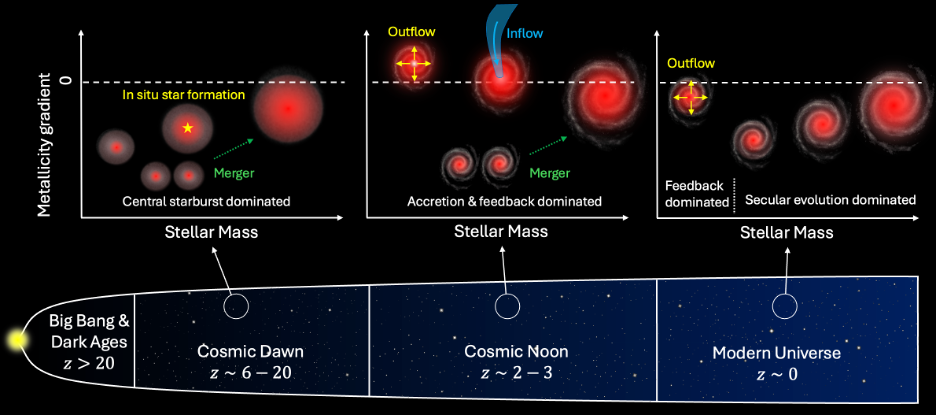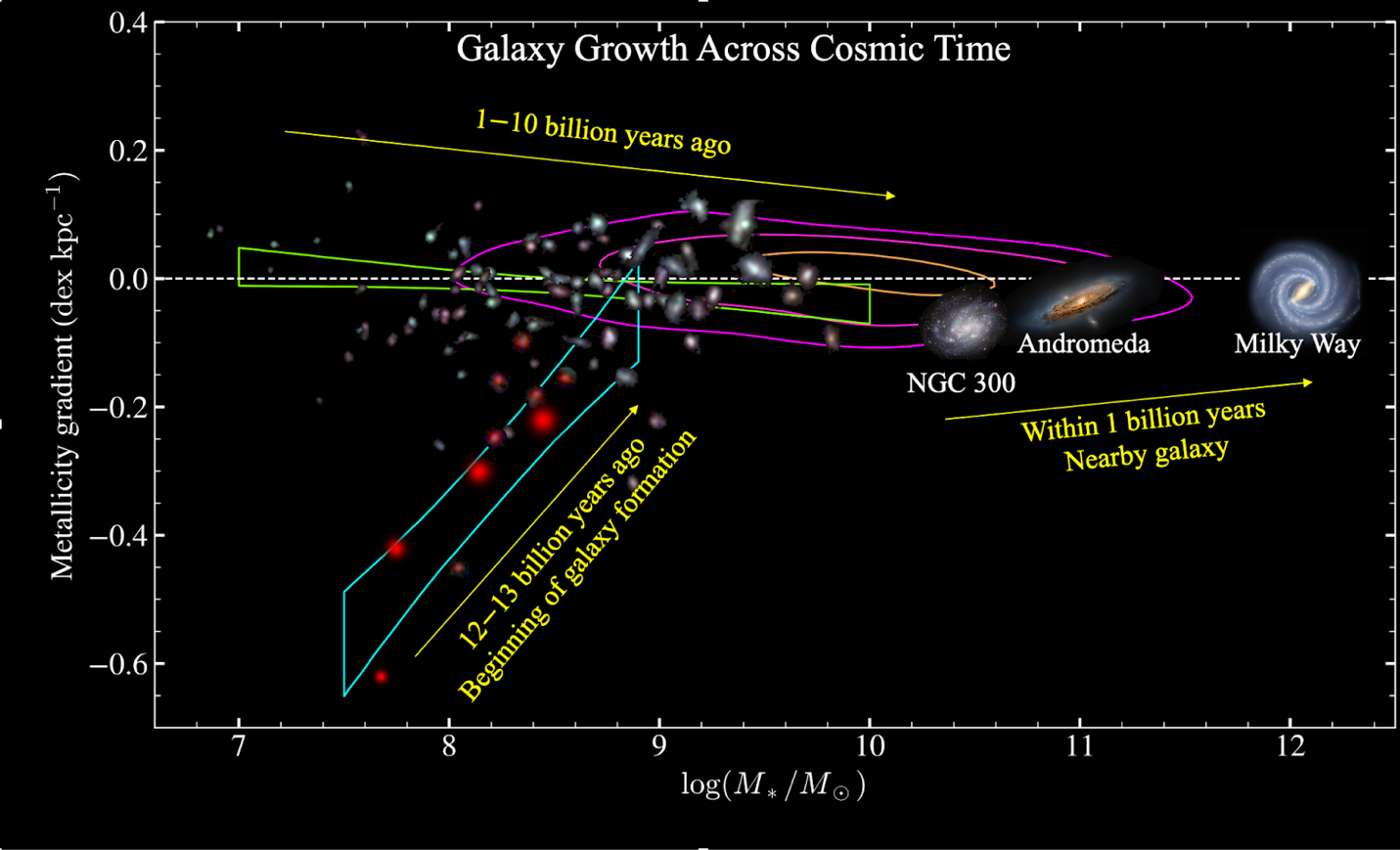By combining the latest observations from the James Webb Space Telescope (JWST) with nearly half a century of Hubble Space Telescope data and contributions from multiple ground-based observatories, astronomers at Tsinghua University have mapped the metallicity gradients from the early Universe to the nearby galaxies. During the 13 billion years of cosmic history, the distribution of heavy elements has caused unique signatures in galaxies.
Distribution of heavy elements – “growth rings” of galaxy evolution
When stars form, shine, and die, they produce elements heavier than hlium, such as oxygen, which enrich their surroundings through the death and explosion of stars. These elements, often referred to as “metals” by astronomers, are redistributed through a complex interplay: supernova explosions push them outward, cold gas inflows dilute central concentrations, and galaxy mergers stir them into a more homogeneous mix.
By examining how these metals are distributed from galaxy centers to their outskirts, researchers can reconstruct how galaxies grow.

Cosmic Dawn: “Inner high, outer low” metals — galaxies grow inside-out
At "cosmic dawn," about 13 billion years ago, the first generations of stars produced the universe’s earliest heavy elements. Intense bursts of star formation quickly enriched the inner regions of galaxies, while over time, metals spread outward, flattening the chemical gradients. This pattern provides strong evidence for inside-out growth, where galaxies build from dense, star-forming centers toward their edges.
Cosmic noon: Chaotic metal distribution, sometimes “inner low, outer high” — a fierce interplay of gas inflows and outflows, star formation and quenching.
Fast forward to around 10 billion years ago, the so-called “cosmic noon.” Here, star formation across the universe reached its maximum. Stellar winds and supernova explosions dispersed metals far beyond galactic borders, erasing the earlier metallicity patterns. During this epoch, metallicity gradients became more strongly linked to gas flows, turbulence, and feedback processes: signs that galaxies were growing in a more global and turbulent way.
Modern universe: Metals return to “inner high, outer low” — the slow “breathing” of modern galaxies
Today, star formation has slowed, and metals once again accumulate in the centers of galaxies. The gradients show a weaker, but still noticeable, correlation with mass. This indicates that gradual, slower processes, such as gas accretion, the formation of spiral arms, and the settling of bar structures, now dominate galactic evolution.
Taken together, the record of nearly a thousand galaxies paints a vivid picture of a 13-billion-year “migration of elements,” a cosmic breathing cycle of enrichment, mixing, and renewal.

Modeling the cosmic cycle
To understand the underlying physics behind the observations, the team compared them with theoretical models of galaxy growth. At early times, their results match a “Feedback-Free Starburst” scenario, where star formation was intense but mixing was inefficient. At cosmic noon, comparisons between observations and the classical “bathtub model” highlight the importance of stronger feedback, gas inflows, and gas recycling.
These findings provide both observational evidence and theoretical guidance for understanding early galaxy formation. They offer benchmarks for hydrodynamical simulations, constraining the roles of turbulence, diffusion, and supernova feedback in models of galactic evolution.
This work has been published in The Astrophysical Journal Supplement Series, entitled “A 13-Billion-Year View of Galaxy Growth: Metallicity Gradient Evolution from the Local Universe to z=9 with JWST and Archival Surveys.” (https://doi.org/10.3847/1538-4365/adfa70)
Zihao Li, formerly a master student at the Department of Astronomy, Tsinghua University, and now a Ph.D. student at the University of Copenhagen, is the first author. Zheng Cai (Tsinghua University) and Xin Wang (National Astronomical Observatories) are the co-corresponding authors. This work is supported by the National Science Foundation of China, the science research grants from the China Manned Space Project, and the Tsinghua University Initiative Scientific Research Program. Collaborating institutions include the National Astronomical Observatories, the Hebrew University of Jerusalem, and a total of 23 international institutions.

